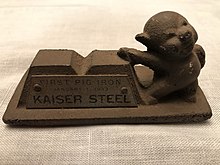Kaiser Steel
Kaiser Steel (later Kaiser Ventures and CIL&D), headquartered in Fontana, California, was founded by Henry J. Kaiser to provide steel plate for the Pacific Coast shipbuilding industry, which expanded during World War II, then shrank, then expanded again during the Korean War. California Shipbuilding Corporation on Terminal Island, California, was one of these shipyards which built hundreds of Liberty ships and Victory ships in World War II, and was also a project of Henry Kaiser.[1][2] Kaiser Steel was noted for making the most of its costly steelmaking inputs, and it captured, along with the U.S. Steel plant in Utah, much of the Pacific Coast steel market by the late 1950s. Its assets included steelmaking plants in Napa, California (that it acquired from Basalt Rock Company in 1955)[3] and Fontana, California (now operated by California Steel Industries),[3] and a former open-pit iron ore mine at Eagle Mountain, California. Steel manufactured was also used in Kaiser Motors.

Kaiser worked with Dr. Sydney Garfield to establish prepaid medical care via the Kaiser Health Plan, the Fontana steel plant workers becoming early members.
Kaiser closed its mills in the 1980s.[3] It was subsequently subject to buyouts and a 1987 bankruptcy filing,[3] before reemerging as Kaiser Ventures in the 1990s. It sold land in Fontana to Penske Motorsports to create the California Speedway (now called the Auto Club Speedway) and leased its water rights to San Bernardino County. After a failed attempt to convert its former mine in Eagle Mountain into a landfill, it was sold to Eagle Crest Energy for a hydroelectric project.[4]
Writer Ayn Rand visited Kaiser Steel in October 1947, as part of her research for the novel Atlas Shrugged, a large part of which takes place at the fictional "Rearden Steel". The Journals of Ayn Rand include numerous items on the plant's daily routine, including both detailed technical information on the process of smelting and the terminology involved, for example: "Blast furnaces are usually named after women. The one at Kaiser's is named 'Bess' after Mrs. Kaiser and is referred to by the workers as 'Old Bess'".
The Fontana site was the location where the steel mill scene was filmed at the end of the 1991 science fiction action film Terminator 2: Judgment Day, as well as the Outworld scenes for the 1995 movie version of Mortal Kombat. The site was also the location for an underground rave party in 1995 called Stargate, which thousands attended after being shuttled in from a nearby shopping center. The impact of globalization on Kaiser employees was explored in the documentary series Peoples Century.
In 2011, a book about the rise and fall of Kaiser Steel in Fontana was published. The Steel Works, by Earle Anderson, chronicles his thirty-year career at the mill and his interactions with those who worked there from 1943 to 1984.
References
- Sawyer, L. A. and Mitchell, W. H., The Liberty Ships, second edition, pp. 1–12, 61 –76, 183–88, Lloyd's of London Press Ltd., London, 1985.
- Herman, Arthur. Freedom's Forge: How American Business Produced Victory in World War II, pp. 137, 178, 258, 212-14, 273, Random House, New York, NY. ISBN 978-1-4000-6964-4.
- Courtney, Kevin (October 17, 2004). "Napa Pipe plant loads its final rail car". Napa Valley Register. Retrieved September 24, 2011.
- "Eagle Crest buys site for 1,300-MW pumped-storage hydro project". Retrieved 2018-07-29.
Works cited
- Mike Davis, City of Quartz, Chapter 7, "Junkyard of Dreams"
- Earle Anderson, Halo Publishing, 2011, “The Steel Works”